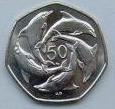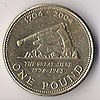| ISO 4217 | |
|---|---|
| Code | GIP (numeric: 292) |
| Subunit | 0.01 |
| Unit | |
| Plural | Pounds |
| Symbol | £ |
| Denominations | |
| Subunit | |
| 1⁄100 | Penny |
| Plural | |
| Penny | Pence |
| Symbol | |
| Penny | p |
| Banknotes | |
| Freq. used | £5, £10, £20, £50 |
| Rarely used | £100 |
| Coins | 1p, 2p, 5p, 10p, 20p, 50p, £1, £2, £5 |
| Demographics | |
| Official user(s) | |
| Unofficial user(s) | |
| Issuance | |
| Government | Government of Gibraltar |
| Website | www |
| Valuation | |
| Inflation | 2.0% (2013 est.) |
| Source | |
| Pegged with | sterling at par |
The pound (sign: £; ISO code: GIP) is the currency of Gibraltar. It is pegged to – and exchangeable with – British pound sterling at par value. Coins and banknotes of the Gibraltar pound are issued by the Government of Gibraltar.
History
Main article: Gibraltar realUntil 1872, the currency situation in Gibraltar was complicated, with a system based on the real being employed which encompassed British, Spanish and Gibraltarian coins. From 1825, the real (actually the Spanish real de plata) was tied to the pound at the rate of 1 Spanish dollar to 4 shillings 4 pence (equivalent to 21.67 pence today). In 1872, however, the Spanish currency became the sole legal tender in Gibraltar. In 1898, the Spanish–American War made the Spanish peseta drop alarmingly and the pound was introduced as the sole currency of Gibraltar, initially in the form of British coins and banknotes.
In 1898, sterling coin was made sole legal tender, although the Spanish peseta continued in circulation until the Spanish Civil War. Since 1927, Gibraltar has issued its own banknotes and, since 1988, its own coins. Gibraltar decimalised in 1971 at the same time as the UK, replacing the system of 1 pound = 20 shillings = 240 pence with one of 1 pound = 100 (new) pence.
Relationship with the British pound
The since repealed Currency Notes Act 1934, conferred on the Government of Gibraltar the right to print its own notes.
Notes issued are either backed by Bank of England notes at a rate of one to one, or can be backed by securities issued by the Government of Gibraltar. Although Gibraltar notes are denominated in "pounds sterling", they are not legal tender anywhere in the United Kingdom. Gibraltar's coins are the same weight, size and metal as British coins, although the designs are different, and they are occasionally found in circulation across Britain.
Under the Currency Notes Act 2011 the notes and coins issued by the Government of Gibraltar are legal tender and current coin within Gibraltar. British coins and Bank of England notes also circulate in Gibraltar and are universally accepted and interchangeable with Gibraltarian issues.
Coins
| 1 pound | |
|---|---|
 
| |
| Obverse | Reverse |
In 1988, coins in denominations of 1, 2, 5, 10, 20 and 50 pence and 1 pound were introduced which bore specific designs for and the name of Gibraltar. They were the same sizes and compositions as the corresponding British coins, with 2-pound coins introduced in 1999. A new coin of 5 pounds was issued in 2010 with the inscription "Elizabeth II · Queen of Gibraltar". This issue caused controversy in Spain, where the title of King of Gibraltar historically corresponds to the Crown of Castile.
| £0.01 | £0.02 | £0.05 |
|---|---|---|

|

|

|
| Barbary partridge | Europa Point Lighthouse | Barbary macaque and Gibraltar candytuft |
| £0.10 | £0.20 | £0.50 |

|

|

|
| Europort | Our Lady of Europe | Bottlenose dolphins |
| £1.00 | £2.00 | |

|

|
|
| Fortress and Key | Pillars of Hercules |
The £2 coin has featured a new design every year since its introduction, as it depicts each of the 12 Labours of Hercules.
Tercentenary edition
In 2004 the Government of Gibraltar minted a new edition of its coins to commemorate the tercentenary of British Gibraltar (1704–2004).
| £0.01 | £0.02 | £0.05 |
|---|---|---|

|

|

|
| Barbary macaque | Keys of Gibraltar | Constitution Order (1969) |
| £0.10 | £0.20 | £0.50 |

|

|

|
| Operation Torch (1942) | Discovery of Neanderthal skull in Gibraltar (1848) |
Battle of Trafalgar (1805) |
| £1.00 | £2.00 | |
 |
 |
|
| Great Siege of Gibraltar (1779–1783) |
Capture of Gibraltar (1704) |
2005 series
In 2005, the Government of Gibraltar issued a new series of coins featuring the designs of the Tercentenary issues, being placed on different denominations. A £5 coin was issued for this series, depicting the Rock of Gibraltar.
| £0.01 | £0.02 | £0.05 |
|---|---|---|
| |
|
|
| Commonwealth Park | Small Boats Marina | Windsor Bridge |
| £0.10 | £0.20 | £0.50 |
| |
|
|
| Barbary Patridge | Dolphins | Skywalk |
| £2.00 | ||
| | ||
| Sandy Bay |
Banknotes
At the outbreak of the First World War, Gibraltar was forced to issue banknotes to prevent paying out sterling or gold. These notes were issued under emergency wartime legislation, Ordinance 10 of 1914. At first, the typeset notes were signed by hand by Treasurer Greenwood, though he later used stamps. The notes bore the embossed stamp of the Anglo-Egyptian Bank Ltd. and circulated alongside British Territory notes. The 1914 notes were issued in denominations of 2/-, 10/-, £1, £5 and £50. The 2/- and £50 notes were not continued when a new series of notes was introduced in 1927. The 10/- note was replaced by the 50p coin during the process of decimalization. In 1975, £10 and £20 notes were introduced, followed by £50 in 1986. The £1 note was discontinued in 1988. In 1995, a new series of notes was introduced which, for the first time, bore the words "pounds sterling" rather than just "pounds". The government of Gibraltar introduced a new series of banknotes beginning with the £10 and £50 notes issued on July 8, 2010. On May 11, 2011, the £5, £20 and £100 notes were issued. In 2021, the government of Gibraltar introduced a new series of banknotes in a reduced size, closely matching that of the banknotes of the Bank of England. The first note, the £5 was issued into circulation in 2021.
| Circulating banknotes (2010-2011 Issue) | ||||||
|---|---|---|---|---|---|---|
| Image | Denomination | Dimensions | Dominant colour | Description | ||
| Obverse | Reverse | Obverse | Reverse | |||
| £5 | 133 × 70 mm | Green | Queen Elizabeth II, Coat of Arms of Castle with Key |
Upper Ward and Tower of Homage of the Moorish castle | ||
| £10 | 141 × 75 mm | Blue | Queen Elizabeth II, Coat of Arms of Castle with Key |
Artist John Trumbull’s “The Sortie Made by the Garrison of Gibraltar” depicting Spanish and English troops fighting and General George Eliott with officers attending to the dying Don José de Barboza during the Great Siege of Gibraltar, 1779–83; | ||
| £20 | 150 × 80 mm | Orange | Queen Elizabeth II, Coat of Arms of Castle with Key |
HMS Victory returning to Gibraltar being towed by HMS Neptune after the Battle of Trafalgar | ||
| £50 | 157 × 85 mm | Red | Queen Elizabeth II, Coat of Arms of Castle with Key |
Casemates Square buildings | ||
| £100 | 164 × 90 mm | Purple | Queen Elizabeth II, Coat of Arms of Castle with Key |
King's Bastion | ||
| Circulating banknotes (2021 Issue) | ||||||
|---|---|---|---|---|---|---|
| Image | Denomination | Dimensions | Dominant colour | Description | ||
| Obverse | Reverse | Obverse | Reverse | |||
| £5 | 125 × 65 mm | Green | Queen Elizabeth II, Coat of Arms of Castle with Key |
Windsor Bridge | ||
| Current GIP exchange rates | |
|---|---|
| From Google Finance: | AUD CAD CHF CNY EUR GBP HKD JPY USD GBP JPY USD |
| From Yahoo! Finance: | AUD CAD CHF CNY EUR GBP HKD JPY USD GBP JPY USD |
| From XE.com: | AUD CAD CHF CNY EUR GBP HKD JPY USD GBP JPY USD |
| From OANDA: | AUD CAD CHF CNY EUR GBP HKD JPY USD GBP JPY USD |
See also
- Economy of Gibraltar
- Currency board
- Christopher Ironside, OBE, coin designer: reverse design of the 25 New Pence coin, Barbary ape (issued 1971).
References
- "Comercios de La Línea aceptan el pago en libras". ELMUNDO. 6 November 2017.
- "GIP". Investopedia.com. Retrieved 19 January 2015.
- ^ Bond, Peter (2003). 300 Years of British Gibraltar 1704-2004. Peter-Tan Publishing Co. p. 89.
- Government of Gibraltar (June 1934). "Currency Notes Act" (PDF). Archived from the original (PDF) on 2008-10-29. Retrieved 2007-08-05.
- ^ "CURRENCY NOTES ACT 2011" (PDF). Gibraltarlaws.gov.gi. Archived from the original (PDF) on 16 May 2019. Retrieved 3 October 2018.
- "Money - Gibraltar (British Overseas Territory) travel advice". GOV.UK. Retrieved 27 June 2023.
- 'Queen of Gibraltar' in new coin, Panorama, 7 May 2010
- Polémica en ámbitos diplomáticos por la asistencia de la reina doña Sofía a los actos de homenaje a Isabel II: consideran que puede perjudicar los intereses soberanos españoles, El Confidencial Digital, 6 May 2012
- Linzmayer, Owen (2012). "Gibraltar". The Banknote Book. San Francisco, CA – via BanknoteNews.com.
{{cite book}}: CS1 maint: location missing publisher (link) - "Gibraltar new note family now complete - Banknote News". Banknotenews.com. Archived from the original on 27 October 2015. Retrieved 3 October 2018.
Bibliography
- Krause, Chester L.; Clifford Mishler (1991). Standard Catalog of World Coins: 1801–1991 (18th ed.). Krause Publications. ISBN 0873411501.
- Pick, Albert (1994). Bruce, Colin R. II; Shafer, Neil (eds.). Standard Catalog of World Paper Money: General Issues (7th ed.). Krause Publications. ISBN 0-87341-207-9.
External links
- Banknotes of Gibraltar: Catalog of Gibraltar Shillings and Pounds
- The current banknotes of Gibraltar (in English and German)
| Sterling banknotes | |||||||||||||
|---|---|---|---|---|---|---|---|---|---|---|---|---|---|
| England and Wales |
| ||||||||||||
| Scotland |
| ||||||||||||
| Northern Ireland (currently issued) |
| ||||||||||||
| Northern Ireland (no longer issued) |
| ||||||||||||
| Crown Dependencies | |||||||||||||
| British Overseas Territories (at parity with sterling) | |||||||||||||
| See also | |||||||||||||
| Euro topics | |||||||||
|---|---|---|---|---|---|---|---|---|---|
| General | |||||||||
| Administration | |||||||||
| Fiscal provisions | |||||||||
| Economy | |||||||||
| International status | |||||||||
| Denominations |
| ||||||||
| Coins by country with minting rights |
| ||||||||
| Non-EU territories using euro per agreement without minting rights | |||||||||
| Potential adoption by other countries | |||||||||
| Countries and territories using euro unilaterally | |||||||||
| Other extant EU currencies |
| ||||||||
| History |
| ||||||||
| Currencies of Europe | |
|---|---|
| European Union |
|
| Eastern |
|
| Southern | |
| Western |
|
| Currency units named pound, lira, or similar | |
|---|---|
| Circulating | |
| Local alternative currency | |
| Defunct |
|
| Historical antecedents (mass) |
|
| See also | |
